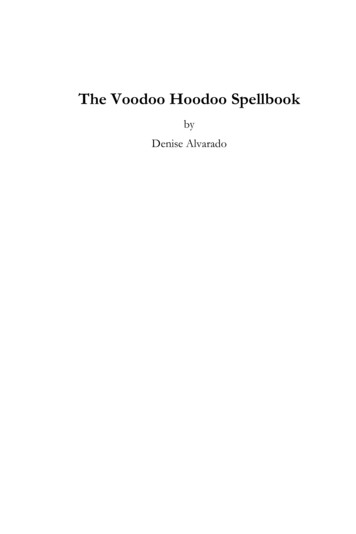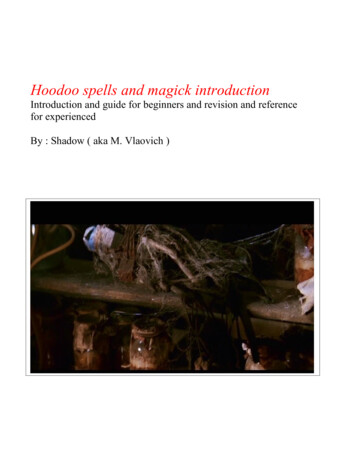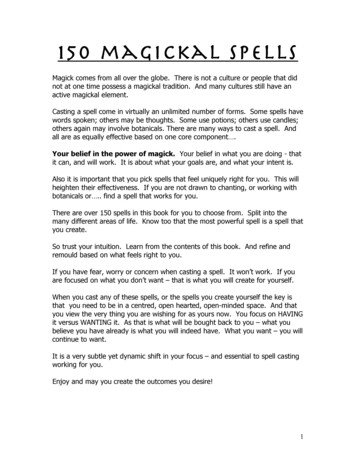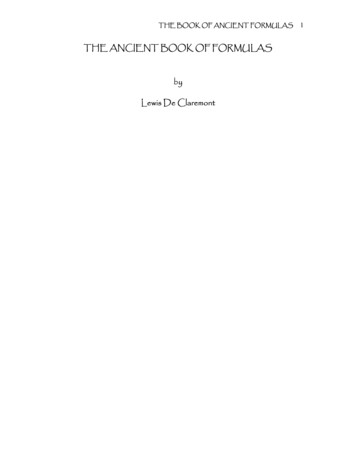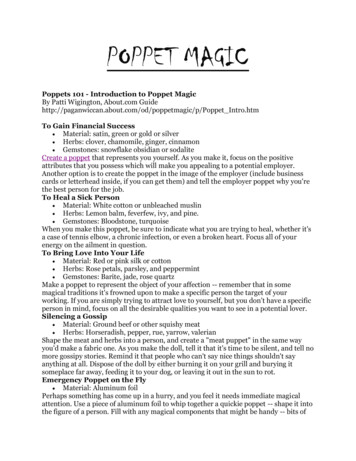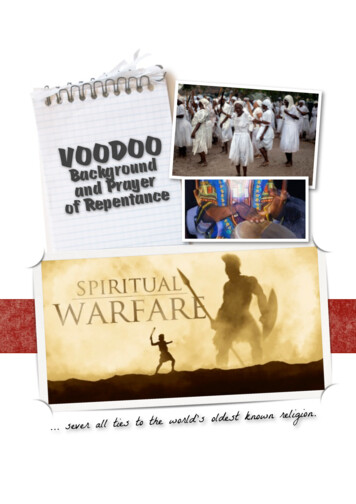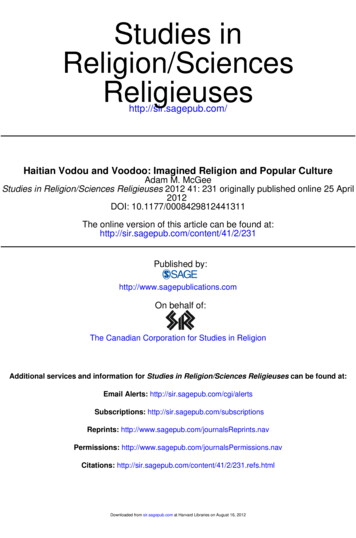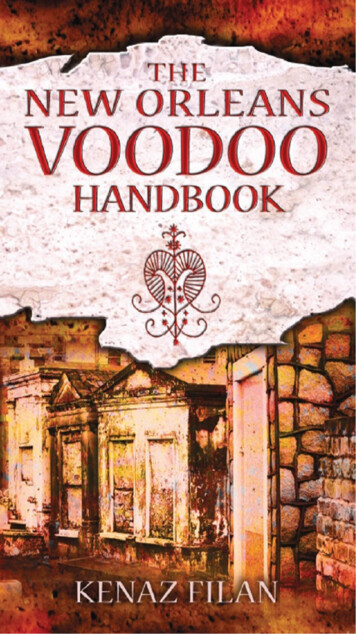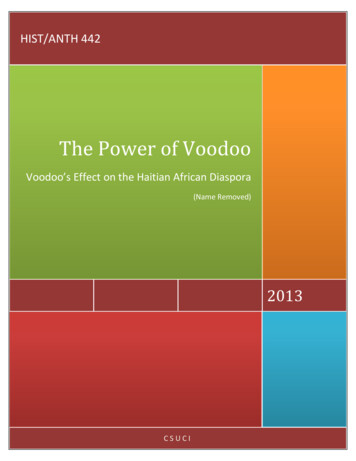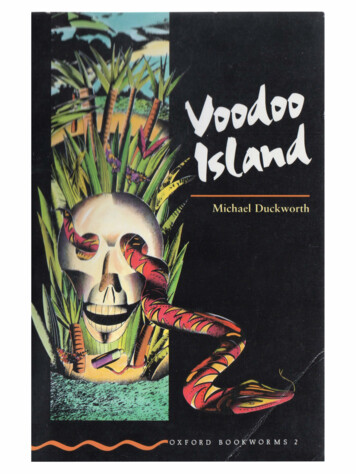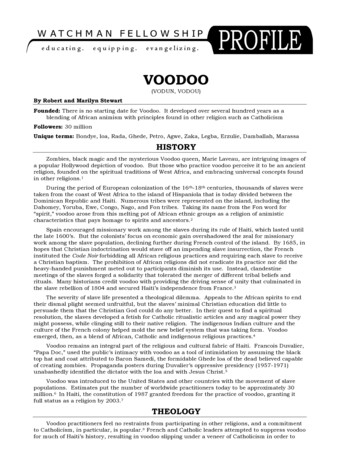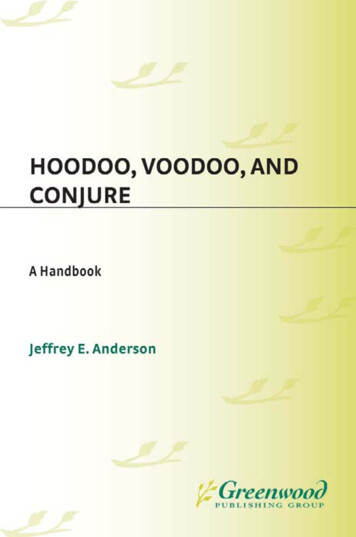
Transcription
Hoodoo, Voodoo, and Conjure
Recent Titles inGreenwood Folklore HandbooksFairy Lore: A HandbookD.L. AshlimanSouth Asian Folklore: A HandbookFrank J. KoromStory: A HandbookJacqueline S. ThursbyChicano Folklore: A HandbookMaría Herrera-SobekGerman Folklore: A HandbookJames R. DowGreek and Roman Folklore: A HandbookGraham AndersonThe Pied Piper: A HandbookWolfgang MiederSlavic Folklore: A HandbookNatalie KononenkoArab Folklore: A HandbookDwight F. ReynoldsCaribbean Folklore: A HandbookDonald R. HillFoodways and Folklore: A HandbookJacqueline S. ThursbyChildren’s Folklore: A HandbookElizabeth Tucker
Hoodoo, Voodoo,and ConjureQA HandbookJeffrey E. AndersonGreenwood Folklore HandbooksGREENWOOD PRESSWestport, Connecticut London
Library of Congress Cataloging-in-Publication DataAnderson, Jeffrey E., 1974–Hoodoo, voodoo, and conjure : a handbook / Jeffrey E. Anderson.p. cm. — (Greenwood folklore handbooks, ISSN 1549–733X)Includes bibliographical references and index.ISBN 978–0–313–34221–9 (alk. paper)1. Hoodoo (Cult)—Handbooks, manuals, etc. 2. Magic—Handbooks,manuals, etc. 3. Voodooism—United States—Handbooks, manuals, etc.I. Title.BL2490.A65 2008133.4'308996073—dc222008020832British Library Cataloguing in Publication Data is available.Copyright 2008 by Jeffrey E. AndersonAll rights reserved. No portion of this book may bereproduced, by any process or technique, without theexpress written consent of the publisher.Library of Congress Catalog Card Number: 2008020832ISBN: 978–0-313–34221–9ISSN: 1549–733XFirst published in 2008Greenwood Press, 88 Post Road West, Westport, CT 06881An imprint of Greenwood Publishing Group, Inc.www.greenwood.comPrinted in the United States of AmericaThe paper used in this book complies with thePermanent Paper Standard issued by the NationalInformation Standards Organization (Z39.48–1984).10987654321
To Lynn, Michael, and David—my family
This page intentionally left blank
ContentsPrefaceixOneIntroduction1TwoDefinitions and Classifications29ThreeExamples and Texts57FourScholarship and 147Web Resources171Index179
This page intentionally left blank
PrefaceReferences to hoodoo, Voodoo, and conjure seem to be everywhere thesedays. They appear in works by prominent authors, including some by ToniMorrison, Alice Walker, and Ishmael Reed—to name but the most prominent.Articles on the doings of Voodoo practitioners are common in newspapers andmagazines. Marie Laveau, the “Voodoo Queen of New Orleans,” has become acelebrated figure in scholarly circles. Three different Laveau biographies have hitthe shelves in recent years. Several movies, most notably The Skeleton Key , haveintroduced African American magic to an even broader audience. One prominent hoodoo practitioner, Catherine Yronwode, now offers an e-mail- or paperbased correspondence course for aspiring practitioners through her business, theLucky Mojo Curio Company (Pryse and Hortense).The only problem with all the attention hoodoo and related practices havegarnered from the media is that the average American does not have much context in which to situate references to African American magic. It is doubtfulthat most could give straightforward definitions of hoodoo, Voodoo, or conjure orexplain why hoodoo and Voodoo are not quite synonymous. Even less expected isthat more than a handful could properly situate these systems of belief withinAfrican American history, folklore, and everyday life.Just as important to Americans’ cloudy ideas of hoodoo, conjure, and Voodooare the stereotypes that surround supernaturalism. Magic, especially the varietyintroduced into America by Africans, has long been associated with superstition,ignorance, or downright devil worship. These stereotypes have been present sincethe days when New Englanders were hanging witches, as evidenced by the factthat at least one of the accused was a believer in and possible practitioner of Voodoo. True, the number of executions of accused magic workers has significantlydeclined over the centuries, but African American believers and practitioners still
xPrefacereceive more than their fair share of disparaging remarks in the popular press.The very presence of hoodoo often makes news, as was true in early 2003 whenword got out that Michael Jackson allegedly used Voodoo to hex his enemies(Breslaw; “Magazine: Jackson Resorts to Voodoo”). In addition, one’s race oftenhas little impact on these stereotypes. African Americans are almost as likely tosee Voodoo and hoodoo as diabolic practices as are whites. Folktales current inblack society that accuse conjurers of causing illness and death bear out this contention (for examples of such tales, see Kulii, 214–217, 225–230).In addition to the lack of knowledge and stereotypes with which most peopleapproach hoodoo and Voodoo, many assume them to be a part of the past, neverrealizing that they are alive and well. To them, Voodoo conjures up images ofnineteenth-century queens leading midnight ceremonies along the Bayou St.Jean outside New Orleans. Likewise, hoodoo might appear to be a fit subject forthe blues singers of the early twentieth century but not a serious presence today.Conjure seems simply a quaint word, aptly associated with antebellum slavery.Hoodoo, Voodoo, and Conjure: A Handbook is a unique work that seeks to fillgaps in public knowledge and to provide much-needed correctives when public perception diverges from facts. In recent years, a few books have attemptedsimilar tasks. Carolyn Long’s Spiritual Merchants: Religion, Magic, and Commerce,Yvonne Chireau’s Black Magic: The African American Conjuring Tradition, andJeffrey E. Anderson’s Conjure in African American Society are the most prominent examples. Unfortunately for general readers, all of these were written withscholarly audiences in mind. As such, each can be somewhat inaccessible to nonspecialists. The present work, in contrast, has been written with students and thegeneral public in mind. Although in no way “dumbed-down,” it was written withmore than a small cadre of professionals in mind.The most logical way for a book of this sort to begin is by clearly definingwhat it is all about. Most important, what exactly are Voodoo, hoodoo, andconjure, and how do they differ from one another? Voodoo proper is an Africancreole religion, meaning that it is a faith that began in African and adapted tonew conditions in the American South. As a developed system of belief, it has itsown gods, priests, sacred ceremonies, and magic. At the same time, just whichreligion the term designates varies significantly by context. For instance, scholarsfrequently use Voodoo to refer to a West African religion that is more properlycalled Vodu or Vodun. More often, however, one sees Voodoo used to indicate afolk religion of Haiti, the preferred term for which is Vodou. In North America,Voodoo means a religion once popular along the banks of the Mississippi River,especially in the city of New Orleans. To further complicate matters, Voodoo issometimes called Voudou or Vaudou in the United States. A more detailed analysisof the relationship between these religions and the reasons for the multiplicity ofsimilar terms must await a later chapter.
PrefacexiHoodoo, in modern parlance, does not refer to a religion. On the contrary,it designates a body of magical beliefs, with little reference to deities and thetrappings of religious worship. Practitioners generally limit their duties to tellingfortunes, casting spells, and making charms for paying clients; however, this hasnot always been the case. Hoodoo has long been associated with the MississippiValley, as has Voodoo. Evidence strongly indicates that the two share a commonancestry and may once have been synonyms. For purposes of clarity, hoodoo willtypically be used to refer to both African American magic and African creole religion in general, a practice in keeping with historical usage that will also preventthe conflation of conjure and Voodoo.Whereas hoodoo refers to the brand of African American supernaturalismfound along the Mississippi, conjure properly denotes the variety found elsewherein the United States. The term is rarely used today and was already in declineby the early twentieth century. Most modern writers treat it as a synonym forhoodoo, a trend this handbook will adopt except in those instances where thehistorical development of black folk supernaturalism is discussed.Is it true that Voodoo and hoodoo are really just devil worship? The answeris a clear-cut no. From at least the late nineteenth century on, the vast majorityof conjurers have confidently described themselves as Christians. The same hasalso been true of Voodoo practitioners, who often saw no insurmountable conflicts between their African-derived faith and the Catholicism prevalent alongthe Mississippi. Satan does sometimes appear as part of Voodoo and hoodoo,to the extent that African American folklore has preserved numerous formulasfor selling one’s soul to him in exchange for arcane power. Still, most of the talesof pacts with Beelzebub are just that—stories with little basis in fact. In otherwords, many have claimed conjurers gain their powers from the devil, but fewpractitioners have agreed.Finally, can such examples of African American folk spirituality justly be referred to as things of the past? To assume hoodoo, Voodoo, and conjure are deadis to make a grave mistake. Practitioners continue to operate across the nation,especially in cities with a large African American population. New spiritual supply shops, which cater to a hoodoo- and Voodoo-oriented clientele, open on aregular basis. As the presence of online hoodoo courses indicates, the number ofboth believers and professional practitioners appears to be on the rise. This trendis most evident in centers of tourism, most notably New Orleans, where references to Voodoo and African American magic are everywhere. Modern hoodoodoctors and Voodoo priests and priestesses know how to play off the stereotypesto improve their standard of living.This book builds on these general themes and allows readers to develop abasis for understanding the varieties of African American folk magic and religion. Chapter 1 describes the practices of conjure and Voodoo and argues for
xiiPrefacetheir importance to black life and history. Chapter 2 examines the historicalroots of the different varieties of black supernaturalism and analyzes the linksbetween them. Chapter 3 consists of primary source documents accompanied bycommentary. Chapter 4 investigates scholarly and popular viewpoints on hoodoo and Voodoo. Chapter 5 places African American supernaturalism in contextby discussing its impact on other areas of American life.The special features of Hoodoo, Voodoo, and Conjure complete the work andmake it the best available reference on African American folk religion and magicavailable. A glossary defining the terminology unique to hoodoo and relatedblack supernaturalism provides ready answers to many reference questions. Forthose seeking deeper knowledge, a lengthy bibliography is included, which divides both important and obscure sources into categories for easy reference. Inaddition to print sources, this handbook lists a wide range of Internet sources onall aspects of African American supernaturalism free for the perusal of the technologically savvy. A detailed index rounds out the work.Conjure and Voodoo are broad topics. Books and articles about them havebeen appearing for well over a century. Scholarly and popular viewpoints haveconstantly fluctuated between condemnation and admiration for practitioners.This handbook will not be the final word on the topic. It should, however, be thefirst word on hoodoo and Voodoo for anyone who wants to delve deeper into therealm of African American spirituality.WORKS CITEDAnderson, Jeffrey E. Conjure in African American Society . Baton Rouge: Louisiana StateUniversity Press, 2005.Breslaw, Elaine G. “Tituba’s Confession: The Multicultural Dimensions of the 1692Salem Witch-Hunt.” Ethnohistory 44 (1997): 535–556.Chireau, Yvonne. Black Magic: Religion and the African American Conjuring Tradition.Berkeley: University of California Press, 2003.Kulii, Elon Ali. “A Look at Hoodoo in Three Urban Areas of Indiana: Folklore andChange.” Ph.D. diss., Indiana University, 1982.Long, Carolyn Morrow. Spiritual Merchants: Religion, Magic, and Commerce. Knoxville:University of Tennessee Press, 2001.“Magazine: Jackson Resorts to Voodoo.” MSNBC Website. 2003. http://www.msnbc.com/news/880422.asp (March 11, 2003).Pryse, Marjorie and Hortense J. Spillers, ed. Conjuring: Black Women, Fiction, and LiteraryTradition. Bloomington: Indiana University Press, 1985.Skeleton Key , The. Produced by Clayton Townsend. Directed by Iain Softley. 104 min.Brick Dust Productions LLC. DVD.Yronwode, Catherine. Lucky Mojo Curio Company Website. 1995–2006. http://www.luckymojo.com.
QOneIntroductionIn contrast to the current fascination in popular culture with African Americansupernaturalism, it was for many years neglected by scholars. During the twentieth century few scholarly books examined hoodoo in any depth. By far the mostimportant of these was Harry Middleton Hyatt’s five-volume Hoodoo-ConjurationWitchcraft-Rootwork. This impressive work, however, was simply a massive compilation of interviews with believers and practitioners, rendering it of limitedvalue to general readers. To be sure, academics did not entirely ignore conjure.Several articles in the Journal of American Folklore and elsewhere treated hoodooas something worthy of study. Likewise, many folkloric, historical, archaeological, medical, and psychological texts included sections about African Americanmagic. Nevertheless, there was no attempt to synthesize the scattered material.Voodoo, an African American religion once found in the Mississippi RiverValley, received even less attention
The most logical way for a book of this sort to begin is by clearly defining what it is all about. Most important, what exactly are Voodoo, hoodoo, and conjure, and how do they differ from one another? Voodoo proper is an African creole religion, meaning that it is a faith that began in African and adapted to new conditions in the American South. As a developed system of belief, it has its own .File Size: 1MBPage Count: 198
